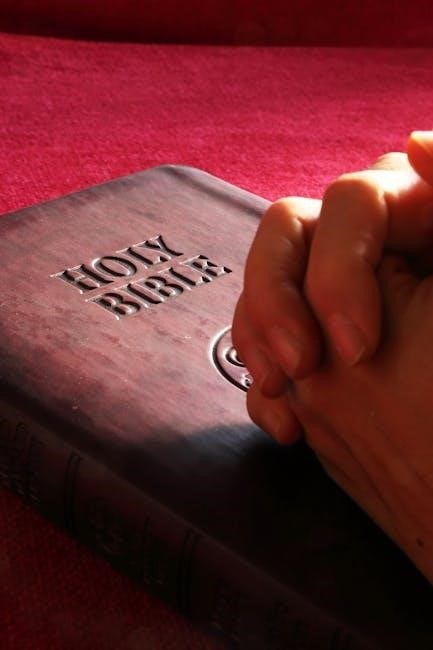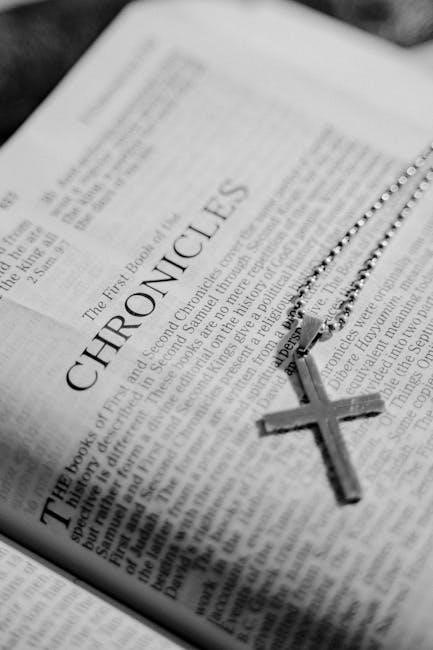The Catholic Bible Timeline Chart is a visual tool that outlines the historical and theological journey of the Bible, offering a comprehensive overview of salvation history. It provides a structured framework for understanding the progression of events, from Creation to the early Church, while highlighting key moments in Catholic tradition. This chart is widely used for educational and devotional purposes, helping believers deepen their faith and grasp the interconnectedness of Scripture.
Purpose and Significance
The Catholic Bible Timeline Chart serves as a visual guide to understanding the narrative of salvation history, connecting biblical events to their historical contexts. Its primary purpose is to provide a clear, organized framework for studying Scripture, making it accessible for both educational and devotional use. By visually representing key moments from Creation to the early Church, the chart helps deepen faith and foster a greater appreciation for the interconnectedness of the Bible. It is particularly valued for its ability to simplify complex theological concepts, making it a powerful tool for Catholics seeking to engage more deeply with their faith. The chart’s significance lies in its universal appeal, benefiting individuals, schools, and parish communities alike, while also offering a shared resource for collective study and reflection.
Overview of the Chart
The Catholic Bible Timeline Chart is a meticulously designed visual aid that chronologically maps the events of the Bible, from Creation to the early Church; It is divided into distinct periods, such as the Patriarchs, Exodus, Kingdom Era, Prophets, and the life of Jesus, each highlighted with specific colors and symbols for clarity. The chart also incorporates key historical events, doctrinal developments, and significant figures, providing a holistic view of Salvation History. Its design allows for easy navigation, making it an invaluable resource for both individual study and group settings. The chart is available in various formats, including printable PDFs, ensuring accessibility for all who seek to explore and understand the Catholic faith through the lens of Scripture.

Historical Context of the Catholic Bible
The Catholic Bible’s historical context traces back to ancient texts and early Church councils, which established the canon, ensuring its teachings align with apostolic traditions and divine inspiration.
Early Church and the Establishment of the Canon
The early Church played a pivotal role in shaping the Catholic Bible. During the 1st to 5th centuries, Church fathers and councils, such as those in Hippo and Carthage, meticulously determined which texts were authoritative and divinely inspired. This process culminated in the official recognition of the New Testament canon in 397 AD. The timeline chart highlights these milestones, showing how the Church ensured the Bible’s authenticity and unity. These decisions laid the foundation for Catholic doctrine and remain central to understanding the Bible’s development. The chart visually maps this journey, offering insights into the historical and theological context of the Canon’s establishment.
Development of the Catholic Bible
The development of the Catholic Bible was a gradual process spanning centuries, shaped by scholarly scrutiny and ecclesiastical councils. The timeline chart illustrates how the Bible evolved from ancient texts to its modern form. Key milestones include the translation of the Septuagint and the Vulgate, which made Scripture accessible to wider audiences. The Councils of Hippo (393 AD) and Carthage (397 AD) formally established the New Testament canon, while the Old Testament retained its deutero-canonical books. The chart also highlights the role of Catholic scholars like St. Jerome in refining the text. Over time, the Bible’s structure and translation have been refined, yet its core teachings remain unchanged. The timeline chart provides a visual journey through these developments, offering a clear understanding of how the Catholic Bible came to be.

Structure of the Timeline
The Catholic Bible Timeline Chart is organized into key periods and events, using color coding to distinguish eras. It spans from Creation to the early Church, highlighting significant moments in salvation history and the development of the Catholic Bible. This visual framework provides clarity and context, making the timeline an essential tool for understanding the progression of Scriptural events and their theological significance.
Divisions and Periods
The Catholic Bible Timeline Chart is divided into distinct periods, each highlighting pivotal moments in salvation history. These divisions include Creation, the Patriarchs, Exodus, the Kingdom Era, Prophets, and the Life of Jesus. Each period is color-coded for clarity, helping users trace the progression of God’s plan. The chart begins with Creation, marking the origins of humanity, and moves through the formation of the Israelites, their journey through the Exodus, and the establishment of the Kingdom. The Prophets section bridges the Old and New Testaments, culminating in the Life of Jesus and the early Church. This structured approach provides a clear visual narrative, making complex biblical events easier to comprehend and study. The divisions and periods are carefully designed to reflect the theological and historical flow of Scripture, aiding in a deeper understanding of the Catholic faith.
Color Coding and Symbolism
The Catholic Bible Timeline Chart employs a vibrant color-coding system to enhance understanding and engagement. Each color represents a specific period or theme, such as creation, the patriarchs, Exodus, the Kingdom Era, prophets, and the life of Jesus. These colors help users visually trace the progression of salvation history. Symbols are also incorporated to denote significant events, like the fall of man, the parting of the Red Sea, or the resurrection of Christ. This visual approach simplifies complex narratives, making the Bible’s timeline accessible to all. The use of color and symbols not only aids in memorization but also creates a visually appealing and educational tool for both personal and communal study. This method ensures that the rich tapestry of biblical events is presented in an organized and aesthetically engaging manner.

Key Events in the Timeline

The Catholic Bible Timeline Chart highlights major events from Creation to the early Church, including the patriarchs, Exodus, Kingdom Era, prophets, and the life of Jesus Christ, providing clarity on biblical progression.
Creation to the Patriarchs
The Catholic Bible Timeline Chart begins with the story of Creation, detailing the formation of the world and humanity. This period emphasizes God’s relationship with His creation, highlighting key events such as the Fall of Man and the Great Flood. The narrative then shifts to the patriarchs—Abraham, Isaac, and Jacob—who play pivotal roles in establishing God’s covenant with His people. Their stories illustrate faith, trust, and divine promises, setting the stage for Israel’s future. This foundational section is essential for understanding the roots of salvation history and God’s plan for humanity, as outlined in the Catholic Bible.

Exodus and the Kingdom Era
The Exodus and the Kingdom Era mark significant milestones in the Catholic Bible Timeline Chart, showcasing God’s deliverance and establishment of His people. The Exodus narrates the Israelites’ liberation from Egyptian bondage, led by Moses, and the reception of the Ten Commandments, forming the covenant at Sinai. This period highlights the construction of the Tabernacle and the beginnings of worship. Transitioning to the Kingdom Era, the timeline follows the rise of kings, notably Saul, David, and Solomon, who shaped Israel’s monarchy. The building of the Temple by Solomon signifies the peak of this era, emphasizing God’s presence among His people. These events underscore divine providence and the formation of Israel’s identity, setting the stage for future prophetic movements and the coming Messiah.
Prophets and the Coming of Christ
The period of the Prophets and the Coming of Christ is a pivotal section in the Catholic Bible Timeline Chart, bridging the Old and New Testaments. Major prophets like Isaiah, Jeremiah, Ezekiel, and Daniel foretold the Messiah’s arrival, emphasizing redemption and God’s covenant faithfulness. Isaiah’s prophecies of a suffering servant and a virgin-born savior are central, while Jeremiah and Ezekiel highlighted the need for spiritual renewal. Daniel’s visions of the Messiah’s triumph over evil kingdoms further illuminated God’s plan. The timeline culminates in the Incarnation, as Jesus Christ fulfills these prophecies, embodying the long-awaited salvation. This era underscores the continuity of God’s plan and the transition from anticipation to realization, marking the dawn of the New Testament and the Church’s foundation.
Life of Jesus and the Early Church
The Catholic Bible Timeline Chart vividly portrays the life of Jesus Christ and the emergence of the early Church, marking the fulfillment of prophetic promises. Jesus’ birth, public ministry, miracles, and teachings are highlighted, emphasizing His divine mission. The timeline underscores the pivotal events of His Passion, crucifixion, and resurrection, which are central to Christian faith. Following His ascension, the timeline transitions to the early Church, detailing the descent of the Holy Spirit at Pentecost and the apostles’ missionary journeys. Key figures like Peter, Paul, and the other disciples are noted for their roles in spreading Christianity. The timeline also covers the persecution of early Christians and the establishment of the Church as the body of Christ, showcasing the foundation of Catholic tradition and doctrine. This section bridges the gap between the Old and New Testaments, illustrating the birth of the Church and its enduring legacy.

Resources for the Catholic Bible Timeline
The Catholic Bible Timeline Chart offers various resources, including PDF downloads, study guides by Jeff Cavins, and printable charts for educational or devotional use, easily accessible online.
PDF Downloads and Accessibility
PDF downloads of the Catholic Bible Timeline Chart are widely available, offering a convenient way to access and study the biblical narrative. These downloadable resources are often free or low-cost, making them accessible to a broad audience. Many charts are designed to be printable, allowing users to create a physical copy for personal study, classroom use, or parish activities. Jeff Cavins’ Bible Timeline Chart is a popular resource, providing a detailed and visually engaging overview of salvation history. The PDF format ensures compatibility with various devices, and some charts are specifically formatted for easy printing on standard paper. Additionally, these resources often include supplementary materials, such as study guides or lesson plans, enhancing their educational value. The availability of these PDFs has made it easier for individuals and communities to deepen their understanding of Scripture in a structured and accessible manner.
Recommended Study Materials
To complement the Catholic Bible Timeline Chart, several study materials are highly recommended for a deeper understanding of Scripture. Jeff Cavins’ The Bible Timeline study program is a cornerstone resource, offering a comprehensive exploration of salvation history. Accompanying DVDs, workbooks, and online courses provide structured learning opportunities. Additionally, books like Monuments, Marvels, and Miracles by Jeff Cavins serve as travel guides, enriching the study experience with historical and cultural insights. The Revised Standard Version (RSV) of the Catholic Bible is also essential, ensuring accurate and accessible Scripture reading. These materials are designed to enhance both individual and group study, fostering a greater appreciation of the Catholic faith and its biblical roots. They are widely available in digital and print formats, making them accessible to all learners.

Practical Applications
The Catholic Bible Timeline Chart is a versatile tool for educational and devotional use, ideal for schools, parishes, and personal study. It enhances group Bible studies and provides a visual framework for understanding Scripture.
Educational Use in Schools
The Catholic Bible Timeline Chart is an invaluable resource for religious education in schools, providing students with a visual and structured understanding of salvation history. Teachers can use the chart to align lessons with curriculum standards, ensuring a comprehensive overview of key biblical events. The PDF format allows for easy printing or digital display, making it accessible for classroom instruction. By integrating the timeline into lesson plans, educators can help students connect historical events with theological concepts. The chart’s clear divisions and color-coded sections facilitate engaging discussions and activities, such as mapping events chronologically or exploring the lives of biblical figures. This tool not only enhances academic learning but also deepens students’ faith formation, fostering a deeper appreciation for Scripture and its relevance in their lives.
Parish and Community Study

The Catholic Bible Timeline Chart is a powerful tool for fostering communal faith growth in parishes and communities. Its visual format makes it ideal for group studies, where members can explore salvation history together. Many parishes use the chart to guide Bible study sessions, fostering deeper engagement with Scripture. The PDF version is easily shared among participants, ensuring everyone has access to the same resource. Community-wide events, such as retreats or lectures, often incorporate the timeline to provide a shared framework for understanding the Bible. This collaborative approach strengthens faith formation and builds a sense of unity among participants. By using the timeline, parishes can create a welcoming environment for spiritual growth and discipleship, helping individuals and groups connect with the richness of Catholic tradition and Scripture.
The Catholic Bible Timeline Chart is an invaluable resource for understanding salvation history, offering a clear and engaging visual guide to Scripture. Its availability in PDF format ensures accessibility for personal and communal study, fostering deeper faith and connection to Catholic traditions.
Final Thoughts on the Timeline’s Value

The Catholic Bible Timeline Chart serves as a transformative tool for engaging with Scripture, offering a clear visual narrative of salvation history. By organizing events chronologically, it helps users appreciate the unity and purpose of God’s plan. The chart’s availability in PDF format makes it accessible for personal, educational, and communal use, ensuring its timeless value. For Catholics seeking to deepen their faith, this resource provides a structured yet flexible framework for study, reflection, and spiritual growth, fostering a deeper connection to the rich tapestry of Catholic tradition and the living Word of God.


